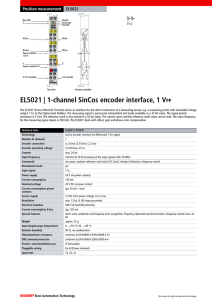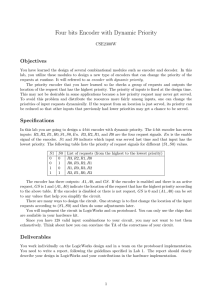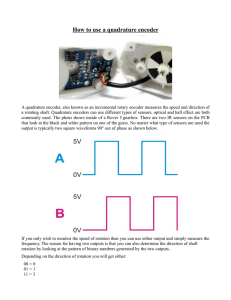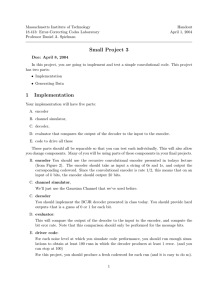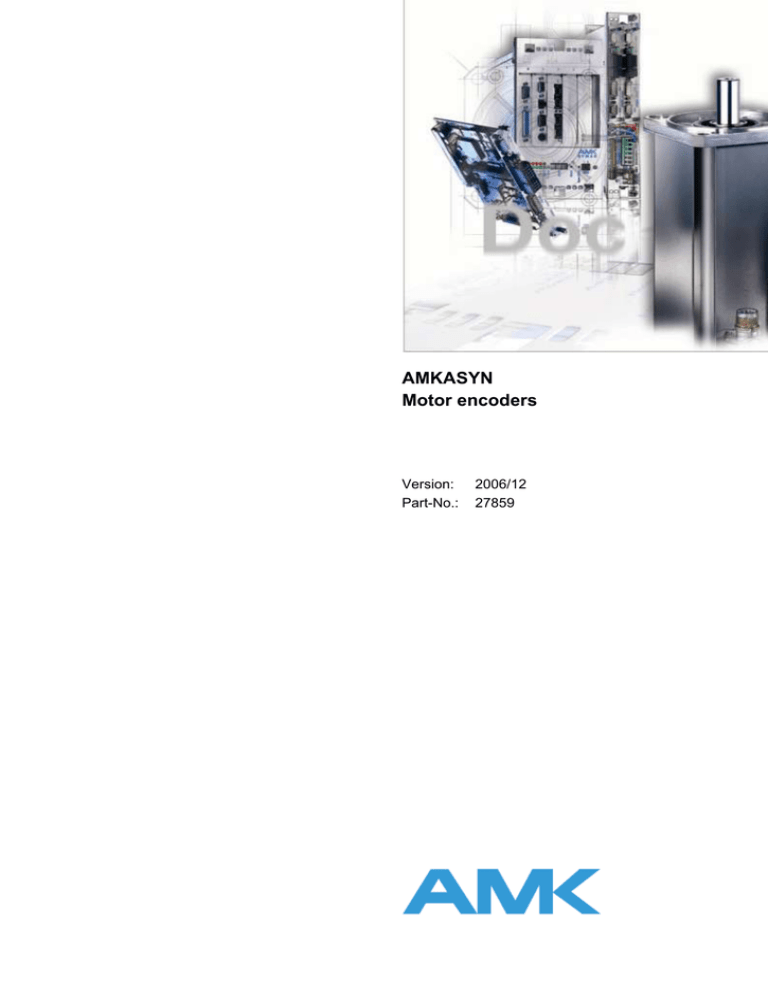
AMKASYN
Motor encoders
Version:
Part-No.:
2006/12
27859
About this documentation
Name:
PDK_027859_Motorgeber_en
Use:
Description of the different motor encoders
What has changed:
Version
Change
Subject
Letter symbol
first Flare version
Bls
2006/12
2008/26
Further Documentation:
Target group:
Representation agreement:
Copyright notice:
Reservation:
© AMK GmbH & Co. KG
Copying, communicating, and using the contents of this documentation is not permitted,
unless otherwise expressed. Offenders are liable to the payment of damages. All rights are
reserved in the event of the grant of a patent or the registration of a utility model or design.
We reserve the right to modify the content of the documentation as well as to the delivery
options for the product.
Publisher:
AMK Arnold Müller Antriebs- und Steuerungstechnik GmbH & Co. KG
Gaußstraße 37 – 39,
73230 Kirchheim/Teck
Tel.: 07021/5005-0,
Fax: 07021/5005-176
E-Mail: info@amk-antriebe.de
Service:
Phone: +49/(0)7021 / 5005-191, Fax -193
Office hours: Mo-Fr 7.30 - 16.30, on weekends and holidays, the telephone number of the
on-call service is provided through an answering machine. .
You can assist us in finding a fast and reliable solution for the malfunction by providing our
service personnel with the following
Information located on the ID plate of the devices
the software version
the device setup and application
the type of malfunction, suspected cause of failure
Internet address:
the diagnostic messages (error messages)
www.amk-antriebe.de
2
Content
1 Motor encoders
1.1 General
1.2 Encoder types, maximum permissible speed
1.3 Motor encoder connection: Connector pin assignment for motor encoder socket
1.4 Signal description
2 Sinusoidal A type encoder (magneto-resistive encoder)
3 Sinusoidal I type encoder (optical encoder)
3.1 Output signals of the I type encoder
4 Absolute T type encoder (SINCOS multiturn)
4.1 T type encoder operating range:
4.2 T type encoder output signals (SIN / COS process data channel):
5 Absolute F type encoder (multiturn with EnDat interface)
5.1 F type encoder operating range
5.2 F type encoder output signals (Sin / Cos):
6 Absolute S type encoder (SINCOS singleturn)
6.1 S type encoder output signals
7 Absolute E type encoder (singleturn with EnDat interface)
7.1 E type encoder output signals (process data channel):
8 Resolver type R
8.1 Resolver signals (principle):
4
4
5
6
7
8
10
10
12
12
13
14
14
14
16
16
17
17
18
19
3
1 Motor encoders
1.1 General
Main task of the motor encoder is the feedback of the rotor position to the inverter processor system. The rotor position is one
important parameter to calculate the current for the field oriented control of the motor.
An incremental rotor position measuring system is sufficient for asynchronous motor control. For the synchronous motor an
absolute rotor position measuring system is required which is oriented to the poles of the permanent magnets on the rotor, thus
facilitating the angle correct current commutation.
Resolver, T/F and S/E type encoders are absolute measuring systems. On resolver and S/E type encoder (singleturn) the
absolute position is related to one motor revolution. The resolution of the T/F type encoder (multiturn) is related to 4096
revolutions. The T/F/S/E type encoders have 2 sinewave output channels (Sin / Cos), which are evaluated incrementally and
additionally a digital interface to read the absolute position of the encoder.
A and I type encoders are incremental encoder systems. Each encoder type is providing the required feedback signals to the
inverter.
Normally motor encoders with sinusoidal output are used on AMKASYN drive systems. The phase sequence of the sine (Sin)
and cosine (Cos) track is used for sensing the direction of rotation. The incremental encoder additionally is generating one
reference pulse (REF) per revolution.
Internal encoder resolution
The actual speed is formed on the inverter by differentiation of the rotor position angle.
In closed loop position control (point-to-point control, synchronous control, stepper motor operation) the motor encoder also
provides the actual position feedback (internal position measuring system).
With transition evaluation of the encoder signals the physically encoder resolution is multiplied by times four. The servo drive
calculates the internal motor encoder resolution:
Motor encoder resolution (ID116) = 4 x sine encoder periods (ID32776) x position refinement (PV)
The position refinement can be set application specific between 1 and 128 and effects a software based fine gradation of the
position
Example:
Sine encoder periods : 1024 periods/revolution
Position refinement PV = 5 (application specific)
ID116 = 4 x 1024 x 5 = 20480 incr
One revolution of the encoder is dissolved by the drive software in 20480 position steps.
The encoder is integrated into the motor coupled with the motor shaft. Encoder connection through a 12 pole circular connector
via shielded cable, twisted pairs. Depending on the inverter type a PHOENIX plug-in terminal block or a D-SUB connector is
used for connection at the inverter end.
The cable shield has to be grounded (PE) at both ends of the cable!
AMK servo drives can evaluate encoders with differential output signals
4
Motor encoder signals (internal signal evaluation)
picture name: ZCH_Geber_Auswertung_Gebersignale
Signal sequence for cw rotation with view onto the motor shaft
1.2 Encoder types, maximum permissible speed
Type Description
R
Resolver (nMax = 15.000 min-1)
I
Optical sine wave encoder, 1000 or 1024 per./rev (nMax = 6.000 min-1) (STEGMANN)
Opt. sine wave enc., 1000(H) or 1024(H) per./rev (nMax = 6.000 min-1) (HEIDENHAIN)
A
Magnetic sine wave encoder, 50 or 100 periods/revolution (nMax = 60.000 min-1)
T
F
Optical absolute encoder, multiturn, max. 4096 turns
SINCOS, RS485: 512 per/rev (nMax = 12.000 min-1) or 1024 per/rev (nMax = 6.000 min-1)
EnDat: 512 per/rev (nMax = 12.000 min-1) or 2048 per/rev (sin/cos) (nMax = 3.000 min-1)
S
E
Optical absolute encoder (singleturn)
SINCOS, RS485: 512 per/rev (nMax =12.000 min-1) or 1024 per/rev. (nMax =6.000 min-1)EnDat: 512 per/rev (sin/cos)
(nMax =12.000 min-1) or 2048 per/rev (nMax =3.000 min-1)
5
1.3 Motor encoder connection: Connector pin assignment for motor encoder socket
Pin
Encoder type
R
I
A
T/S
E/F
1
+Sin
G2N
G2N
G2N
G2N (B+)
2
-Sin
G2I
G2I
G2I
G2I (B-)
3
+Cos
G1N
G1N
G1N
G1N (A+)
4
-Cos
G1I
G1I
G1I
G1I (A-)
5
-
-
-
-
05Psens
6
-
GND
-
GND
GND
7
-
-
-
-
CLK+
8
-
-
-
Motorhousing
CLK-
9
+UREF G0N
G0N
+RS485
DAT+
10
-UREF G0I
G0I -
-RS485
DAT-
11
-
05P
05P
09P
05P
12
-
-
-
-
GNDsens
Cable shield connected to connector housing
Motor encoder connector socket pin assignment
(view on to the socket pins)
picture name: ZCH_Geber_Steckerstifte
6
1.4 Signal description
G0N
Reference pulse
+ Cos
Resolver cosine
G0I
Reference pulse inverted
- Cos
Resolver cosine inverted
G1N
Track 1
+ UREF
Resolver excitation signal
G1I
Track 1 inverted
- UREF
Resolver excitation signal inverted
G2N
Track 2
+RS485
T- / S encoder, data channel +
G2I
Track 2 inverted
- RS485
T- / S encoder, data channel -
05P
Supply 5 V =, max. 250 mA
CLK+
E- / F encoder: EnDat, Clock+
09P
Supply 9 V =, max. 150 mA
CLK-
E- / F encoder: EnDat, Clock-
+ Sin
Resolver sine
DAT+
E- / F encoder: EnDat, Data+
- Sin
Resolver sine inverted
DAT-
E- / F encoder: EnDat, Data-
7
2 Sinusoidal A type encoder (magneto-resistive encoder)
The A type encoder is an incremental encoder (magnetoresistive encoder):
A measuring cogwheel is fixed at the motor shaft with a separate tooth for the reference pulse. The 3 magnetoresistors, located
at the cogwheel circumference, are effected by the teeth. Each tooth is generating a sinewave voltage variation in the
associated magnetoresistor.
During encoder assembling at AMK the magnetoresistors are aligned and adjusted in this way that 2 sinewave signals with 90°
phase difference (SIN / COS) and a reference pulse (REF) are generated as differential output signals.
picture name: ZCH_A_Prin
Measuring cogwheels with 50 or 100 teeth (50 / 100 periods per motor revolution) are used, depending on motor size.
picture name: ZCH_Geber_Signale_A-Geber
8
The differential motor encoder output signals are amplified on the inverter and internally used: as actual rotor position feedback
for actual speed generation
for actual position feedback (internal measuring system).
At initial commissioning the motor encoder adjustment procedure must be activated (e.g. via Control panel). The gain, the offset
and the phase angle are fine tuned by the inverter software.
The resulting correction values are stored in the EEPROM on the inverter. After an inverter or motor exchange the motor
encoder adjustment procedure must be initiated again.
During operation the inverter software is monitoring the encoder signals and compensating temperature effects par example.
The encoder connections are led to a socket for circular connector on the motor. A shielded cabel, twisted-pairs must be used.
Shield connection to PE at both cable ends: At the inverter through the D-SUB shell, at the motor to the motor
housing (PE bolt)!
9
3 Sinusoidal I type encoder (optical encoder)
The I type motor encoder is an incremental encoder. It generates two output signals by scanning evenly etched divisions on a
transparent disk. Two sinewave signals are output with 90° phase difference (SIN / COS) and a reference pulse (REF), each as
a differential signal.
The I type encoder is integrated into the motor. Motor shaft and encoder shaft are coupled. The encoder housing is directly
connected to the motor housing.
The cable shield must be connected to PE at both ends!
1000 lines per revolution (1000 periods / rev.) are output as a standard, 1024 lines per revolution (1024 periods / rev.) as an
option. The currently used encoders are marked by an”H” (HEIDENHAIN) behind the specification “P./rev.” on the motor
nameplate.
With the former I type encoder (STEGMANN) the encoder housing was insulated from the motor housing. For grounding of the
encoder housing the cable shield must be connected to the encoder housing through pin 8 in the encoder connector.
3.1 Output signals of the I type encoder
picture name: ZCH_Geber_Signale_I-Geber
10
Signal sequence for cw rotor rotation with view onto the motor shaft.
The I type encoder is temperature compensated with standardized output signals.
The differential motor encoder output signals are amplified on the inverter and internally used:as actual rotor position feedback
for actual speed generation
for actual position feedback (internal measuring system).
The encoder connections are led to a socket for circular connector on the motor. A shielded cable, twisted-pairs must be used.
Shield connection to PE at both cable ends: At the inverter through the D-SUB shell, at the motor to the motor
housing (PE bolt)!
11
4 Absolute T type encoder (SINCOS multiturn)
Motor encoder type T is a mix of incremental encoder (scanning evenly etched divisions on a transparent disk) and an absolute
multiturn encoder. After Power On the absolute position value is generated in the encoder and transferred to the inverter via RS
485 (data channel).
During operation the sine / cosine tracks on the encoder provide the required feedback signals for the inverter.
The motor encoder type T is used if after Power On the absolute position must be directly available without firstly moving the
axis to its home position.
Absolute encoder resolutions:
4096 turns
Incremental encoder resolution:
1024 or 512 sine / cosine periods per turn
After POWER ON the absolute encoder position must be read through the serial interface RS485, initiated by a call for ”Homing
cycle”. No axis movement is performed in this case. Data transfer through the two wires ”G0N” (+ RS485) and ”G0I” (- RS485)
(normally used for reference pulse output on the standard encoder).
The internal position counter is preset to this position value. Later on, during axis movement only the sine / cosine signals are
evaluated for incremental speed and position feedback (process data channel).
During commissioning the axis travel must be defined within the 4096 turns of the T type encoder. The transition from turn
”4096” to turn ”0” or vice versa is not permissible. It would cause servere positioning problems.
4.1 T type encoder operating range:
picture name: ZCH_Geber_Arbeitsbereich_TF-Geber
12
4.2 T type encoder output signals (SIN / COS process data channel):
Output signals T type encoder (Process data SIN / COS)
picture name: ZCH_Geber_Signale_TS-Geber
The T type encoder is temperature compensated with standardized output signals. The encoder adjustment procedure must not
be activated during initial commissioning and the signal compensation is blocked by the inverter software.
The differential motor encoder output signals are amplified on the inverter and internally used:as actual rotor position feedback
for actual speed generation
for actual position feedback (internal measuring system).
The encoder connections are led to a socket for circular connector on the motor. A shielded cable, twisted-pairs must be used.
The T type encoder housing is mounted insulated at the motor. For grounding of the encoder housing the cable shield must be
connected to the encoder housing through pin 8 in the encoder cable connector.
Shield connection to PE at both cable ends: At the inverter through the D-SUB shell, at the motor to the motor
housing (PE bolt)!
13
5 Absolute F type encoder (multiturn with EnDat interface)
Motor encoder type F is a mix of an incremental encoder (scanning evenly etched divisions on a transparent disk) and an
absolute multiturn encoder. After Power On the absolute position value is generated in the encoder and transferred to the
inverter via EnDat after call for ”homing cycle”. EnDat is a bidirectional interface. The absolute position is output via this
interface and information stored in the encoder can be read or updated.
During operation the sine / cosine tracks on the encoder provide the required feedback signals for the inverter.
Absolute encoder resolution:
4096 turns
Incremental encoder resolution:
2048 or 512 sine / cosine periods per turn
Rotation direction: Increasing code values for cw shaft rotation (view onto the shaft).
The F type motor encoder is used if after Power On the absolute position must be directly available without firstly moving the
axis to its home position.
After POWER ON the absolute encoder position must be read through the EnDat interface, initiated by the call for ”Homing
cycle”. No axis movement is performed in this case. The internal position counter then is preset to this position value.
Later on, during axis movement only the sine / cosine signals are evaluated for incremental speed and position feedback.
During commissioning the axis travel must be defined within the 4096 turns of the F type encoder. The transition from turn
”4096” to turn ”0” or vice versa is not permissible.
5.1 F type encoder operating range
picture name: ZCH_Geber_Arbeitsbereich_TF-Geber
5.2 F type encoder output signals (Sin / Cos):
picture name: ZCH_Geber_Signale_EF-Geber
14
Signal sequence for cw motor shaft rotation with view onto the motor shaft.
The F type encoder is temperature compensated with standardized output signals. The encoder adjustment procedure must not
be activated during initial commissioning and the signal compensation is blocked by the inverter software.
The differential motor encoder output signals are amplified on the inverter and internally used:as actual rotor position feedback
for actual speed generation
for actual position feedback (internal measuring system).
The encoder connections are led to a socket for circular connector on the motor. A shielded cable, twisted-pairs must be used.
Shield connection to PE at both cable ends: At the inverter through the D-SUB shell, at the motor to the motor
housing (PE bolt)!
15
6 Absolute S type encoder (SINCOS singleturn)
Motor encoder type S is a mix of incremental encoder (scanning evenly etched divisions on a transparent disk) and an absolute
single turn encoder. After Power On the absolute position value related to one motor turn is generated in the encoder and
automatically transferred to the inverter via RS485.
During operation the sine / cosine tracks on the encoder provide the required feedback signals for the inverter.
The motor encoder type S is used in conjunction with synchronous motors as an absolute measuring system oriented to the
poles of the permanent magnets on the rotor to facilitate angle correct current commutation.
Absolute encoder resolution:
1 turn
Incremental encoder resolution:
1024 or 512 sine / cosine periods per turn
Rotation direction: Increasing code values for cw shaft rotation (view onto the shaft).
After Power On the absolute encoder position related to one motor revolution is read through the serial interface RS485 and
transferred into a modulo position counter on the inverter. Thus correct current commutation for the synchronous motor is
guaranteed after Inverter On (RF). The two signal leads “G0N” (+RS485) and “G0I” (-RS485) are used for data transmission.
A homing cycle must be performed before changing to operating mode ”Absolute positioning”. On the inverter the internal
position counter then is set to ”0” and the bit ”Axis referenced” is output after the home position is reached.
6.1 S type encoder output signals
picture name: ZCH_Geber_Signal_TS-Geber
The S type encoder is temperature compensated with standardized output signals. The encoder adjustment procedure must not
be activated during initial commissioning and the signal compensation is blocked by the inverter software.
The differential motor encoder output signals are amplified on the inverter and internally used:as actual rotor position feedback
for actual speed generation
for actual position feedback (internal measuring system)
The encoder connections are led to a socket for circular connector on the motor. A shielded cable, twisted-pairs must be used.
The S type encoder housing is mounted insulated at the motor. For grounding of the encoder housing the cable shield must be
connected to the encoder housing through pin 8 in the encoder connector.
Shield connection to PE at both cable ends: At the inverter through the D-SUB shell, at the motor to the motor
housing (PE bolt)!
16
7 Absolute E type encoder (singleturn with EnDat interface)
Motor encoder type E is a mix of incremental encoder (scanning evenly etched divisions on a transparent disk) and an absolute
single turn encoder. After Power On the absolute position value related to one motor turn is generated in the encoder and
automatically transferred to the inverter via EnDat. EnDat is a bidirectional interface. The absolute position is output via this
interface and information stored in the encoder can be read or updated.
During operation the additional sine / cosine tracks on the encoder provide the required feedback signals for the inverter.
The motor encoder type E is used in conjunction with synchronous motors as an absolute measuring system oriented to the
poles of the permanent magnets on the rotor to facilitate angle correct current commutation.
Absolute encoder resolution:
1 turn
Incremental encoder resolution:
2048 or 512 sine / cosine periods per turn
Rotation direction: Increasing code values for cw shaft rotation (view onto the shaft).
After Power On the absolute encoder position related to one motor revolution is read through the EnDat interface and
transferred into a modulo position counter on the inverter. Thus correct current commutation for the synchronous motor is
guaranteed after Inverter On (RF).
A homing cycle must be performed before changing to operating mode ”Absolute positioning”. For “Homing” a reference pulse
is generated internally. On the inverter the internal position counter then is set to ”0” and the bit ”Axis referenced” is output after
the home position is reached.
7.1 E type encoder output signals (process data channel):
picture name: ZCH_Geber_Signale_EF-Geber
Signal sequence for cw motor shaft rotation with view onto the motor shaft.
The E type encoder is temperature compensated with standardized output signals. The encoder adjustment procedure must not
be activated during initial commissioning and the signal compensation is blocked by the inverter software.
The differential motor encoder output signals are amplified on the inverter and internally used:as actual rotor position feedback
for actual speed generation
for actual position feedback (internal measuring system)
The encoder connections are led to a socket for circular connector on the motor. A shielded cable, twisted-pairs must be used.
Shield connection to PE at both cable ends: At the inverter through the D-SUB shell, at the motor to the motor
housing (PE bolt)!
17
8 Resolver type R
The resolver is an absolute encoder related to one motor revolution.
The resolver works on the rotary transformer principle:
The rotor winding and the stator winding are forming a transformer. Different to the simple rotary transformer the resolver is
wound with two windings oriented 90° to one another which are stationary and mounted in a housing, the stator.
The primary winding is located on the shaft of the resolver, the rotor. The effective turns ratio and polarity between the primary
and the secondary windings varies depending on the shaft angle.
picture name: ZCH_Geber_Resolver1
For brushless rotor excitation, stator and rotor each have an additonal winding. Through these windings the reference voltage is
induced in the primary winding. Both additional windings on the rotor are electrically coupled. Thus the excitation voltage,
transmitted through the fix additional stator winding, is feeding the true resolver winding on the rotor.
When the reference AC input voltage (REF), set at a constant frequency, is induced in the primary winding, both output signals
of the stator will have the same frequency but will be out of phase by 90° (SIN and COS outputs).
The important characteristic of the resolver is the peak voltage of each secondary winding. As the shaft rotates, these
amplitudes (SIN / COS) will vary proportionally to the resolver shaft angle.
Information extracted from SIN and COS is translated into a digital format using analog to digital conversion and is further
processed in the drive as the absolute rotor position value. All other feedback signals required in the drive are also derived from
the resolver output signals. Additionally one reference pulse per motor revolution is generated.
The resolver mainly is used in conjunction with synchronous motors as an absolute measuring system oriented to the poles of
the permanent magnets on the rotor of the motor (for angle correct current commutation).
The absolute position from the resolver, related to one motor revolution is directly available after Power On. Thus correct
current commutation for the synchronous motor is guaranteed after Inverter On (RF).
A homing cycle must be performed before changing to operating mode ””absolute positioning”. On the inverter the internal
position counter is set to ””0” and the bit ””axis referenced” is output if the home position is reached.
18
8.1 Resolver signals (principle):
picture name: ZCH_Geber_Resolver2
The encoder connections are led to a socket for circular connector on the motor. A shielded cable, twisted-pairs must be used.
Shield connection to PE single-ended at the inverter. The cable shield in the circular connector must be carefully isolated.
19
AMK Arnold Müller GmbH & Co. KG
Antriebs- und Steuerungstechnik
Gaußstrasse 37-39
73230 Kirchheim/Teck
DEUTSCHLAND
Telefon: +49 (0) 70 21 / 50 05-0
Telefax: +49 (0) 70 21 / 50 05-199
info@amk-antriebe.de
www.amk-antriebe.de



